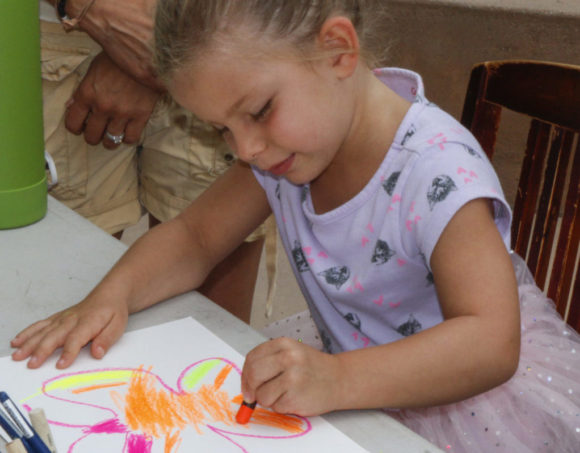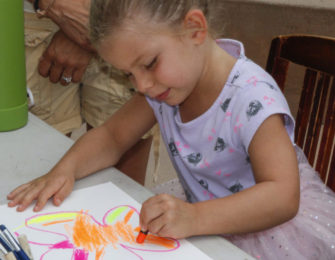Numerous studies have shown that art instruction (especially at a young age) is important for cognitive, social, and emotional development. However, it is disappearing from schools as budgets are cut. Casa Romantica Cultural Center and Gardens ensures that every child has access to the benefits of art instruction by developing art programs for high school youth, middle school youth, elementary school children, and even preschoolers and infants!
Paint and Play, developed by early childhood educators just for Casa Romantica, is our newest program for preschoolers (children ages 2-5 years old) to participate in visual arts activities with a parent or guardian and explore Casa Romantica’s lush gardens!
Read on to see the many developmental benefits of art instruction for your toddler or preschooler.
It helps develop motor skills
- Many of the motions involved in making art, such as holding a paintbrush or scribbling with a crayon, are essential to the growth of fine motor skills in young children. According to the National Institute of Health, developmental milestones around age three should include drawing a circle and beginning to use safety scissors. Around age four, children may be able to draw a square and begin cutting straight lines with scissors. (Source 1)
It facilitates communication
- The visual arts can help children to communicate ideas that they have trouble expressing verbally. Even though the subject matter of a young child’s artwork may not always be obvious, the act of creating art can encourage children to talk about what they are depicting as they work. When this occurs, both the artwork and the dialogue that occurs alongside it are equally important in helping teachers (and parents and caregivers) to better understand the child’s thinking. (Source 3)
It stimulates brain growth
- Participating in art, music, movement, and storytelling activities develops language, mathematics, science, and social skills, AND these activities also strengthen the synapses between brain cells! Research shows that these synapses grow stronger through active participation in the arts. These essential activities at an early age can actually create new neural pathways and fortify those that are already present. At infancy, a child has all the synapses needed to speak any language, to learn and appreciate music and movement, and to create visual art… but these synapses must be used in order to be developed. (Source 2)
It strengthens problem-solving and critical-thinking skills
- According to a report by Americans for the Arts, art instruction strengthens problem-solving and critical-thinking skills. The experience of making decisions and choices in the course of creating art carries over into other parts of life. “If kids are exploring and thinking and experimenting and trying new ideas, then creativity has a chance to blossom,” says MaryAnn Kohl, an arts educator and author of numerous books about children’s art education. (Source 1)
It develops innovation
- When children are encouraged to express themselves and take risks in creating art, they develop a sense of innovation that will be important in their adult lives. “The kind of people society needs to make it move forward are thinking, inventive people who seek new ways and improvements, not people who can only follow directions,” says Kohl. “Art is a way to encourage the process and the experience of thinking and making things better!” (Source 1)
Registration is now open for Paint and Play at Casa Romantica Cultural Center and Gardens! This series is recommended for children ages 2-5. A parent or guardian must be present for the whole class session in order to participate. You must sign up for all 4 sessions. Please only register your child.
Sources:
Source 1: https://www.pbs.org/parents/thrive/the-importance-of-art-in-child-development
Source 2: https://www.scholastic.com/teachers/articles/teaching-content/learning-through-arts/
Source 3: https://theeducationhub.org.nz/an-introduction-to-the-visual-arts-in-early-childhood-education/

 Blog
Blog  Casa Captivating
Casa Captivating  Why is art instruction important for preschoolers?
Why is art instruction important for preschoolers?
 Blog
Blog
 Why is art instruction important for preschoolers?
Why is art instruction important for preschoolers?

